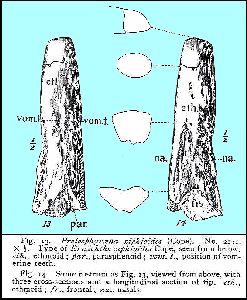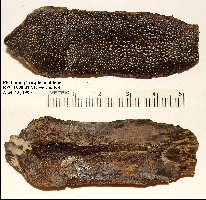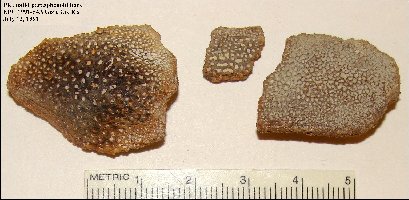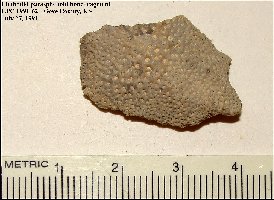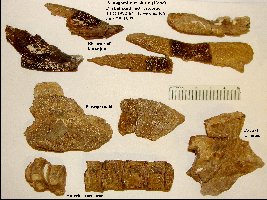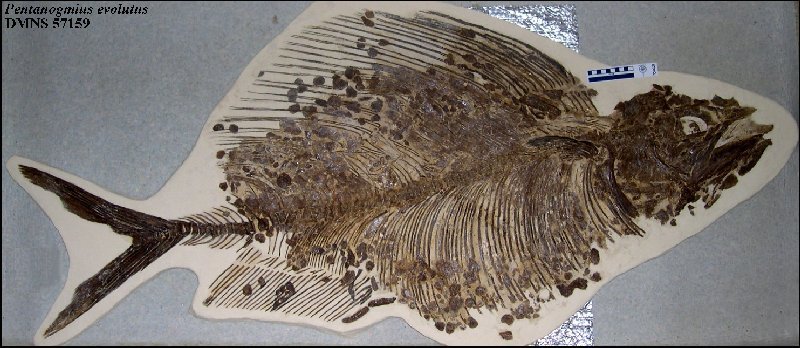 |
Plethodids
Copyright
© 2010-2011 by Mike Everhart
Page
created 02/24/2010 - Updated 08/23/2011
LEFT:
DMNS 57159 - A large and nearly complete Pentanogmius evolutus (Cope) discovered
by Chuck Bonner in the Smoky Hill Chalk of western Kansas. The tail is reconstructed. |
Class
Osteichthyes (Bony Fish)
Subclass Actinopterygii
Subdivision Teleostei (teleost fish)
Order
Tselfatiiformes
Family Plethodidae
Plethodids:
The
plethodids are a fairly common but relatively primitive group of fish that had skeletons
composed of varying amounts of cartilage. In most cases only a small portion of the skull
of the fish is preserved. The Family Plethodidae includes the genera: Niobrara, Zanclites, Luxilites, Syntegmodus, Bananogmius, Pentanogmius ("Anogmius"
evolutus), Martinichthys, Thryptodus, and Plethodus
(a European genus).
Pentanogmius evolutus (Cope)
(This species was recently removed from the genus Bananogmius
and renamed Pentanogmius evolutus by Taverne): A medium sized fish (4 to
6 feet) with a narrow, but deep body
(like an Angel Fish) and jaws that had small,
comb-like teeth. Most of the skeleton was bone and preserved well. A commonly found
fossil is the palatine bone from the roof of the mouth. These have a pebbled surface that
served as the base for hundreds of small, sharp teeth.
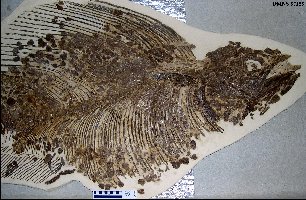 |
LEFT: DMNS 57159 is probably the best preserved, most complete
example known of Pentanogmius evolutus. Shown here in right lateral view. See more photos on the
Keystone Gallery site RIGHT: The skull of DMNS 57159 in right
lateral view. |
 |
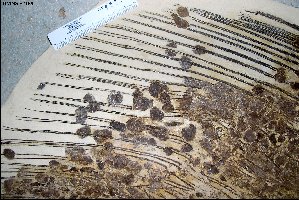 |
LEFT: A close up of the dorsal fin (sail) of DMNS 57159,
showing some of the scales preserved with the specimen.
RIGHT: A close-up of the jaws of DMNS 57159 showing the hundreds of tiny teeth
that covered the jaw plates. |
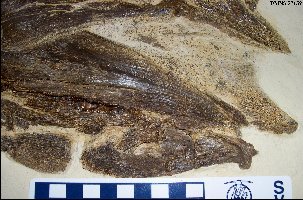 |
Other specimens:
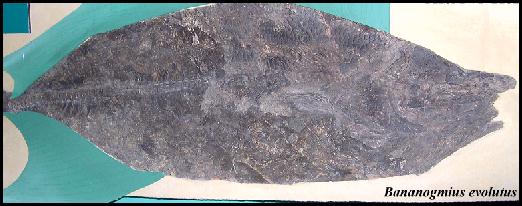
|
LEFT:
The exhibit specimen of Bananogmius (Pentanogmius) evolutus (FHSM
VP-2182) in the collection of the Sternberg Museum. Although not fully displayed in this
photograph of the reconstruction, the fish had a large, sail-like dorsal fin. |
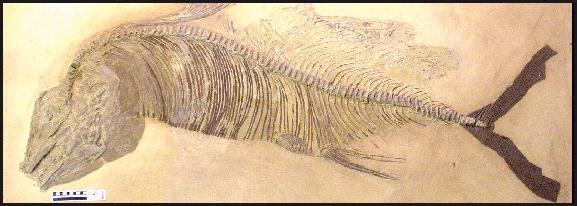
|
LEFT:
Pentanogmius evolutus (FHSM VP-2117) in the collection of the Sternberg
Museum of Natural History. The caudal fin (tail) is reconstructed. A close up view of the
skull is HERE. A view of the teeth on
the lower jaw of another specimen is HERE. |
 |
LEFT: The oddly crushed skull of FHSM VP-2117. RIGHT:
Close-up of one of the tooth bearing elements (left lower jaw?) of FHSM VP-2117 (note that
teeth are missing). |
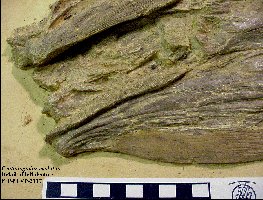 |
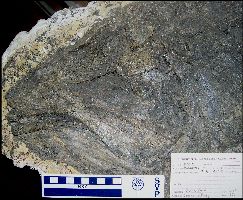 |
LEFT: The skull of a large Bananogmius
(Pentanogmius) evolutus - KUVP 27815 in left lateral view collected from the
Pierre Shale in 1971 by the Orville Bonner party. RIGHT: The type specimen of Bananogmius ellisensis, preserved
uncrushed in a concretion from the Blue Hill Shale Member of the Carlile Shale,
Ellis County, Kansas (Middle Turonian in age). |
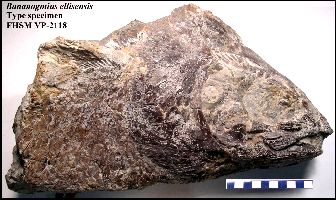 |
 |
LEFT: KUVP 445 - Right lateral view of a large Bananogmius
(Pentanogmius?) specimen collected from a concretion in the Fairport Chalk Member
(Middle Turonian) of the Carlile Shale, Russell County, KS. A detailed view of the skull is here. |
Thryptodus:
Complete
skulls of this strange, "battering-ram" fish are found rarely in the chalk, but
mostly, only the rostrum at the tip of the skull survives. Unfortunately, the type
specimen from the Kansas Chalk was destroyed in Germany during World War II.
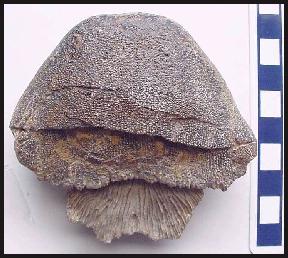
|
LEFT:
The skull of Thryptodus was heavily built, with a rostrum (the ethmoid bone) that
is very massive. Another unusual feature is the flat surface at the anterior
end. How was this fish using its head? Click HERE
for a drawing of the skull of Thryptodus zitteli (from Loomis 1900). |
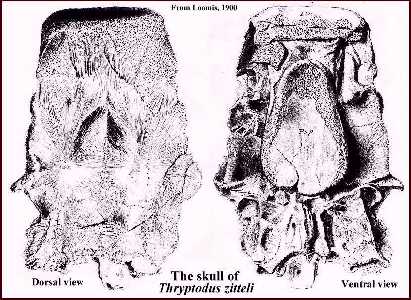 |
LEFT: Complete skulls of Thryptodus have been found
rarely in the chalk. The type specimen of Thryptodus zitteli (from Kansas and
described by Loomis, 1900) was in a museum in Germany that was destroyed by Allied bombs
during World War II. In Kansas, these fish are only found in the lower 1/4 of the
Smoky Hill Chalk and apparently become extinct by the end of Coniacian time (about 86
mya).
More recently, Shimada and Schumacher (2003) described what is
probably the oldest specimen of Thryptodus
(FHSM VP-13996) from the Lincoln Limestone (Middle Cenomanian) Member of the Greenhorn
Limestone Formation in Russell County, KS. |
 |
A dorsal view of two 'noses' of Thryptodus zitteli (FHSM
VP-15571 / EPC 1995-34 and FHSM VP 15572 / EPC 1999-01), The anterior end is at the bottom
of the scan. The size of the two fish must have been about the same. |
 |
A ventral view of the same two specimens. Both of these
specimens had other skull material and vertebrae associated with them, including a large,
flat parasphenoid bone that covered the roof of the mouth. |
 |
The 'business end' of the two specimens showing the flat surface
of the 'nose'. What were these 'battering ram' like adaptations used for? Three
views of a recently discovered Texas specimen are shown HERE,
HERE, and HERE.
Based on specimens I have seen recently from Texas, the species seems to be more common
there. |
Martinichthys:
These
fish are somewhat mysterious in that they are only known to occur in Kansas, and only in a
relatively narrow section (less than 20 ft in thickness) of the chalk. There are only two
partial skulls of these fish known and few vertebrae. One of them (KUVP 497) is shown here.
Additional
web page:
Martinichthys, mystery
fish from the chalk
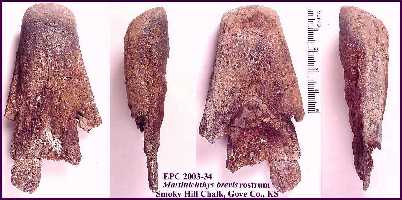
|
These
fish are usually represented in the fossil record only by a hard, blunt nose or rostrum.
These rostra are often worn off at an angle as if the fish was using it to hammer at a
hard substrate such as shells. The teeth are very small and comb-like in appearance. These
fish only occur in a narrow zone in the lower 1/3 of the chalk. They are relatively rare
(found only in Kansas) and there are less than 85 examples in collections. Most of the
specimens are in the collections of the Sternberg Museum and the Museum of Natural History
at the University of Kansas.
LEFT:
FHSM VP-15567 - A recently discovered (2003), well-preserved Martinichthys brevis
rostrum from the lower Smoky Hill Chalk of Gove County, KS. |
Plethodid
fossils: The most common plethodid fossils collected in the Smoky Hill
Chalk are the parasphenoid bones... a flat, roughly rectangular bone on the roof
of the mouth that is has hundreds of small pits.... These pits held small teeth
when the fish was alive.
Other
Plethodids:
Relatively
rare and unknown. These specimens are in the KU Museum of
Natural History:
 |
LEFT: The skull of Ferrifrons rugosus
Jordan 1924 (KUVP 296), the anterior portion of a complete specimen (damaged). It was
almost 75 years later that this species was determined to be a plethodid (see Arratia and
Chorn. 1998. Journal of Vertebrate Paleontology, 18(2): 301-314. The original specimen is
24.5 inches long and was collected by H.T. Martin about 4 miles northeast of Gove, in Gove
County, KS. |
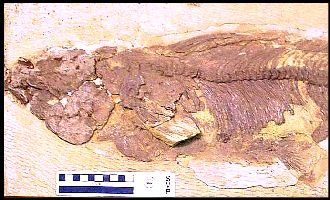
|
LEFT:
Niobrara encarsia Jordon 1924 - This specimen was collected by H.T. Martin in
Trego County. Another view of the type specimen
(KUVP 179). |
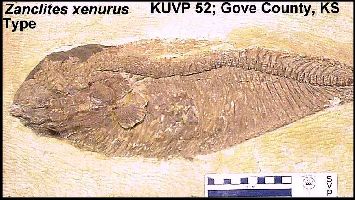
|
LEFT:
Zanclites xenurus Jordon 1924 - This specimen was collected by H.T. Martin about 1/2
mile northeast of Gove, Gove County, KS. Another
view of the type specimen (KUVP 52) |
Other
Oceans of Kansas webpages on Late Cretaceous fish:
Field Guide to Sharks and Bony
Fish of the Smoky Hill Chalk
Sharks:
Kansas Shark Teeth
Cretoxyrhina and Squalicorax
Ptychodus
Chimaeroids
Bony Fish
Pycnodonts and Hadrodus
Plethodids:
Pentanogmius
Martinichthys
Thryptodus
Bonnerichthys
Protosphyraena
Enchodus
Cimolichthys
Pachyrhizodus
Saurodon and Saurocephalus
Xiphactinus
REFERENCES:
Cope, E. D., 1877. On some new or little known reptiles and fishes
of the Cretaceous No. 3 of Kansas. Proceedings of the American Philosophical Society
17(100):176-181. (Anogmius and Stratodus)
Cope, E. D., 1877. On the genus Erisichthe.
Bulletin U. S. Geological and Geographical. Survey iii, article xx. pp. 821-823. (first
description of Martinichthys)
Everhart, M. J. and P. A. Everhart, 1992. Oyster-shell
concentrations; a stratigraphic marker in the Smoky Hill Chalk (upper Cretaceous) of
western Kansas. Kansas Academy of Science, Transactions, 11(Abstracts):12.
Everhart, M. J. and P. A. Everhart, 1993. Notes on the
biostratigraphy of the plethodid Martinichthys in the Smoky Hill Chalk (upper
Cretaceous) of western Kansas. Kansas Academy of Science, Transactions, 12(Abstracts):36.
Everhart, M. J. and P. A. Everhart, 1994. Evidence of predation on
the rare plethodid Martinichthys in the Smoky Hill Chalk (upper Cretaceous) of
western Kansas. Kansas Academy of Science, Transactions, 13(Abstracts):36.
Fielitz, C. and K. Shimada, 1999. A new species of Bananogmius
(Teleostei; Tselfatiformes) from the Upper Cretaceous Carlile Shale of western Kansas.
Journal of Paleontology 73(3):504-511
Jordon, D.S. 1924. A collection of fossil fishes in the University
of Kansas from the Niobrara Formation of the Cretaceous. University Kansas Science
Bulletin, 15(2): 219-245.
Loomis, F. B. 1900. Die anatomie und die verwandtschaft der Ganoid- und Knochen-fische
aus der Kreide-Formation von Kansas, U.S.A. Palaeontographica, 46: 213-283.
McClung, C. E. 1926. Martinichthys, a new genus of Cretaceous fish from
Kansas, with descriptions of six new species. Proceedings of the American Philosophical
Society 65 no. 5, (suppl.) 20-26, 2 pls.
Shimada, K. and B. A. Schumacher, 2003. The earliest record of the
Late Cretaceous fish, Thryptodus (Teleostei: Tselfatiiformes), from central
Kansas. Kansas Academy of Science, Transactions 106(1-2):54-58.
Taverne, L., 1999. Révision du genre Martinichythys, poisson marin
(Teleostei, Tselfatiirormes) du Crétecé supérior du Kansas (États-Unis). Geobios
33(2):211-222. (Revision of the genus Martinichthys, marine fish (Teleostei,
Tselfatiiformes) from the Late Cretaceous of Kansas (United States))
Taverne, L., 1999. Revision de Zanclites xenurus,
Teleosteen (Pisces, Tselfatiiformes) marin du Santonian (Cretace superior) du Kansas
(Etas-Unis). Belg. Journal Zool. 129(2):421-438. (in French)
Taverne, L., 2000. Tselfatia formosa, teleosteen marin du
Cretace (Pisces, Actinopertygii), et la position systematique des Tselfatiiformes ou
Bananogmiiformes. Geodiversitas 22(1):5-22. (in French)
Taverne, L. 2000. Osteology et position systematique du genre Plethodus,
et des nouveaux genres Dixonangomius et Pentanogmius, poissons du
Crétacé (Telostei, Tselfatiiformes). Biologisch Jaarboek Dodonaea 67(1):94-123. (in
French)
Taverne, L. 2001. Révision de Niobrara encarsia
téléostéen (Osteichthyes,Tselfatiiformes) du Crétacé supérieur marin du Kansas
(Etats-Unis). Belg. Journal Zool., 131(1):3-16. (in French)
Taverne, L., 2001. Révision de Syntegmodus altus
(Teleostei, Tselfathformes), poisson marin du Crétacé supérieur du Kansas (Etats-Unis).
Cybium 25(3):251-260. (in French)
Taverne, L., 2001. Révision du genre Bananogmius
(Teleostei, Tselfatiiformes), poisson marin du Crétecé supérior d'Amérique du
Nord et d'Europe. Geodiversitas 23(1):17-40. (Revision of the genus Bananogmius
(Teleostei, Tselfatiiformes), marine fish from the Upper Cretaceous of North America and
Europe).
Taverne, L., 2002. Révision de Luxilites striolatus
poisson marin (Teleostei, Tselfatiiformes) du Crétacé supérieur du Kansas
(États-Unis). Belg. Journal Zool. 132(1):25-34.
Taverne, L., 2002. Étude de Pseudanogmius maiseyi gen.
et. sp. nov., poisson marin (Teleostei, Tselfatiiformes) du Crétacé supérieur du Kansas
(États-Unis). Geobios 35:605-614. (Study of Pseudanogmius maiseyi gen. and sp.
nov., marine fish (Teleostei, Tselfatiiformes) from the Late Cretaceous of Kansas (United
States) - Holotype is AMNH 8129.
Taverne, L. 2003. Redescription critique des genres Thryptodus, Pseudothryptodus et
Paranogmius, poissons marins (Telostei,
Tselfatiiformes) du Crétecé supériorr des Etats-Unis d’ Egypte et de Libye. Belgian Journal of Zoology 133(2):163-173.
Taverne, L. 2004. Ostéologie de Pentanogmius
evolutus (Cope, 1877) n. comb. (Teleostei, Tselfatiiformes) du Crétacé supérieur
marin des États-Unis. Remarques sur la systématique du genre Pentanogmius Taverne
2000. Geodiversitas 26(1):89-113. <LT>

















